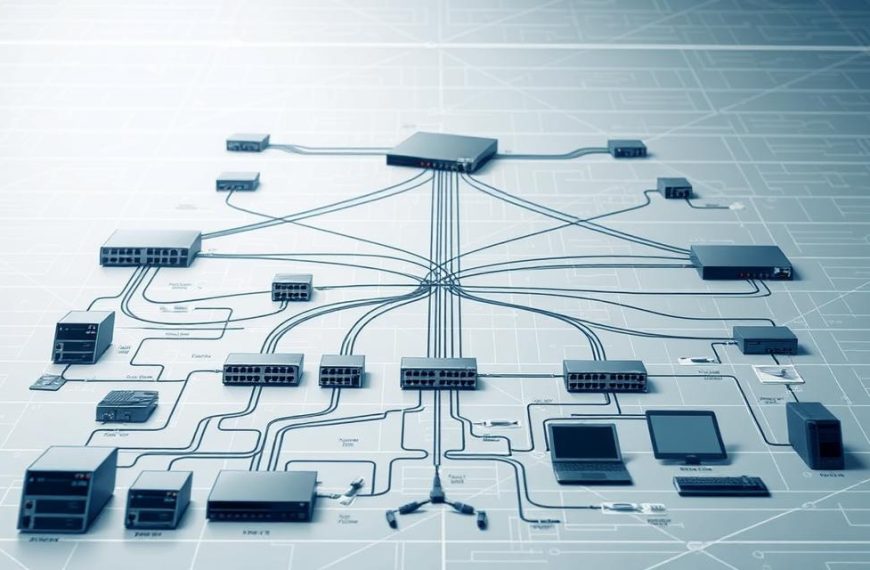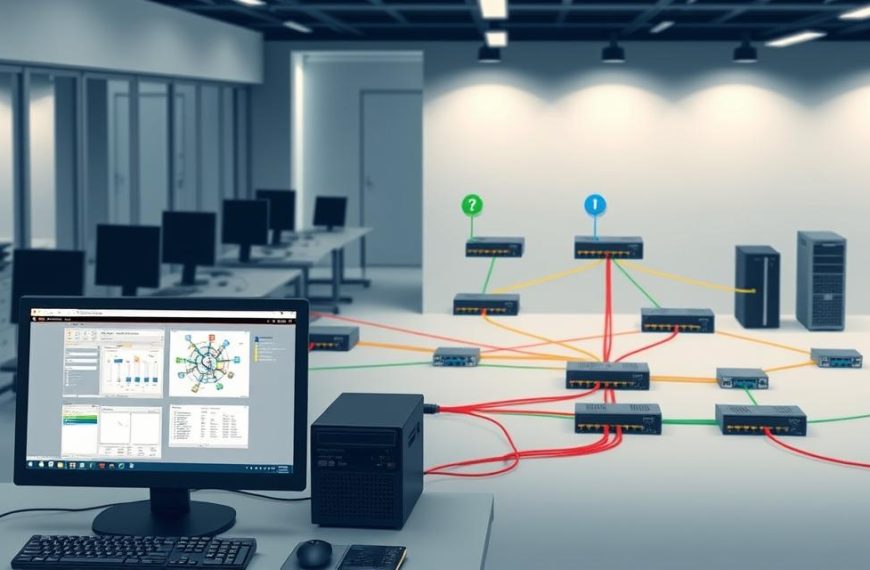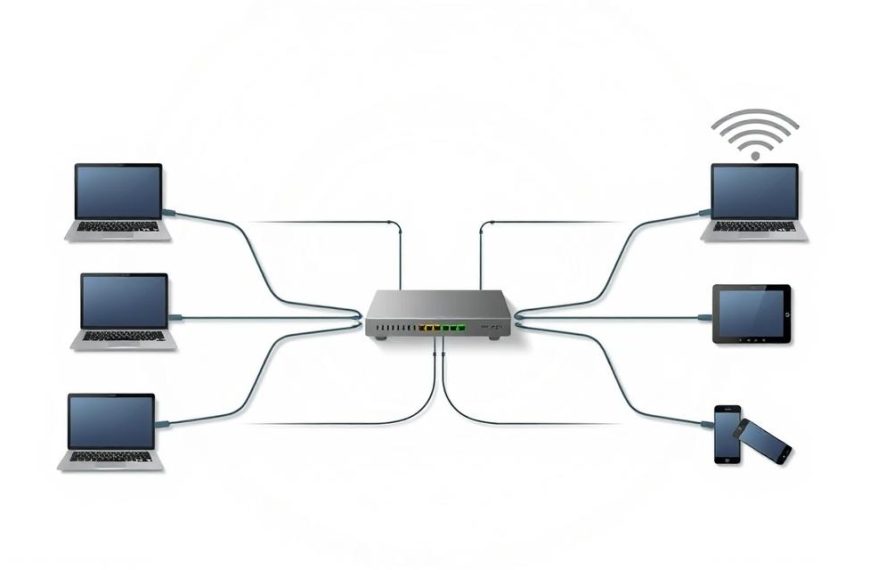Today’s digital world depends on networks that link devices for easy communication. These networks are groups of systems working together to handle information well.
The main goal is to make processing faster and more efficient. This leads to quicker and better results.
There are many computer network types to meet different needs. They help share resources, making everything more efficient.
Knowing about these networks helps us see their good and bad sides. We’ll look at the benefits and challenges in more detail later.
What is a Computer Network Advantages and Disadvantages: An Overview
Computer networks are key to our digital world. They connect devices to share resources and information. Knowing how they work helps us see their good and bad sides in different places.
Basic Components and Functionality
A computer network is made up of devices that work together. They exchange data and share resources. The main parts are computers, servers, routers, switches, and cables.
Software is also vital. It helps data move smoothly between devices. Together, hardware and software make systems for local and remote access.
Network security keeps these connections safe. Good data management keeps information in order and safe for those who should see it.
Types of Networks in Modern Use
There are many network types, each for a specific use. They vary in size and purpose. Each has its own strengths and weaknesses.
The main types are:
- Local Area Network (LAN): For devices in a small area, like an office
- Wide Area Network (WAN): Covers big areas, linking many LANs
- Metropolitan Area Network (MAN): Serves areas bigger than LANs but smaller than WANs, like cities
- Personal Area Network (PAN): For devices in one person’s space
| Network Type | Coverage Area | Typical Use Cases | Transmission Speed |
|---|---|---|---|
| LAN (Local Area Network) | Up to 1 kilometre | Offices, schools, homes | High (100 Mbps – 10 Gbps) |
| WAN (Wide Area Network) | Unlimited geographical range | Corporate networks, internet | Variable (56 Kbps – 10 Gbps) |
| MAN (Metropolitan Area Network) | City-wide coverage | University campuses, city services | Medium to High |
| PAN (Personal Area Network) | Personal workspace | Device connectivity, peripherals | Low to Medium |
Each network type has its own security and data management needs. The right choice depends on what an organisation needs, its budget, and technical needs.
Knowing about these networks helps organisations pick the best one for their needs. It also helps them prepare for any challenges they might face.
Key Advantages of Using Computer Networks
Computer networks change how businesses work by linking systems together. They bring big benefits that go beyond just connecting devices. These changes help businesses work better and grow.
Enhanced Collaboration and Communication
Today’s networks make teamwork easy with collaboration tools. Tools like Microsoft Teams and Zoom work well with networks. They let teams share documents and talk face-to-face in real time.
This makes teams work together smoothly, no matter where they are. They can make decisions faster and solve problems in new ways.
Efficient Resource Sharing and Cost Reduction
Networks help save money by letting many users share expensive things. Instead of buying many printers or software, businesses can share them. This saves money upfront and on upkeep.
It also means:
- Less need for duplicate hardware in different departments
- Lower costs for software licences because everyone shares
- Less money spent on IT support because it’s all managed from one place
Scalability and Centralised Data Management
Networks grow with your business, making it easy to add more users and devices. This means you can expand without spending a lot of money.
Having all data in one place makes it safe and easy to manage. This brings many benefits:
- Easy backups from one spot
- Stronger security with who can access what
- More reliable data and fewer mistakes
Users can get to files they need from anywhere, but safely. This mix of growth and control is great for businesses to grow.
Significant Disadvantages of Computer Networks
Computer networks have many benefits but also face big challenges. These include security worries and financial costs. Both need careful planning and ongoing management.
Security Threats and Vulnerability Issues
One major issue is security vulnerabilities that can harm data. Networks have many ways for bad actors to get in, so strong protection is key.
Keeping networks safe is a constant battle. Threats change fast. To stay safe, use firewalls, encryption, and check for security issues often.
Examples of Common Network Security Problems
Network admins face many threats:
- Malware infections that spread quickly
- Attempts to get into systems without permission
- Phishing to steal login details
- Ransomware that locks up important files
These problems show why it’s vital to always be ready to protect networks.
Network Dependence and Reliability Concerns
Today, many businesses rely on their networks for daily work. This makes them vulnerable when the network goes down.
If a key server fails, it can stop everything. This means lost time and trouble getting work done.
To avoid these problems, have backup plans. This includes having extra systems ready to take over if needed. Without these, networks can be down for a long time.
High Implementation and Ongoing Costs
Setting up a network costs a lot. You need to buy hardware, cables, servers, and more.
After setting it up, there are ongoing costs. These include:
- Keeping the network running smoothly
- Buying new security software
- Pay for IT staff
- Replacing old parts
These costs are a big part of any business budget. They cover more than just setting up the network. They also include keeping it running and secure.
When planning a network, think about these downsides. Good planning and investing in security can help avoid many problems. This keeps the network working well.
Practical Considerations for Network Implementation
Going from theory to practice needs careful planning. Organisations must think about security and infrastructure. This ensures their networks meet their needs well.
Best Practices for Network Security
Strong security is essential in today’s digital world. A multi-layered defence is the best way to fight threats.
Key security steps include:
- Using detailed firewall systems
- Encrypting data from start to end
- Setting up strict access rules
- Keeping software up to date
- Doing security checks often
These steps need skilled IT staff and training. A security expert says:
“Network security is not just a one-time thing. It’s a constant effort to stay alert and adapt to new dangers.”
Choosing the Appropriate Network Setup
The right network setup depends on many factors. Where your organisation is located is a big factor.
Important things to think about are:
- How big the area you need to cover
- How much you might grow
- If you need to manage data from one place
- Your budget and what resources you have
Different networks are for different needs. Here’s a table showing main network types and what they’re good for:
| Network Type | Coverage Area | Best For | Scalability |
|---|---|---|---|
| LAN (Local Area Network) | Single location | Small offices, schools | Limited |
| WAN (Wide Area Network) | Multiple locations | Large corporations | High |
| MAN (Metropolitan Area Network) | City-wide | Municipal organisations | Moderate |
For growth, choose solutions with great scalability. A centralised server setup is often the best. It helps grow operations while keeping data safe and consistent.
Conclusion
Computer networks are changing the digital world. They make communication, teamwork, and sharing resources easier. They help businesses and people work better and manage data well.
But, there are big challenges too. Security threats, reliability issues, and high costs are real problems. Finding a good balance is key to success.
Keeping your network safe is essential. Use firewalls, encryption, and keep software up to date. Planning your network well is important for growth.
Every business needs to think about what it needs. The right setup and following best practices are vital. A well-thought-out network helps you use its benefits fully.
Computer networks are vital tools. Their success depends on making smart choices and being proactive. Use their power wisely, but also be aware of the challenges.
















